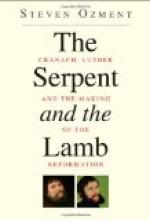More than ten years passed before this new principle began to work off the putrid carcass of mediaeval religion which lay stretched over the stifled and suffocating Church of Christ. There were yet many steps and stages in the preparation for what was to come. But from that time forward everything moved toward general regeneration by means of that marrow doctrine of the Gospel: Salvation by loving faith in the merit and mediation of Jesus alone.
Staupitz counseled the young monk to study the Scriptures well and whatever could aid him in their right understanding, and gave orders to the monastery not to interfere with his studies.
On May 2, 1507, he was consecrated to the priesthood.
Within the year following, at the instance of Staupitz,
Frederick the
Wise appointed him professor in the new University
of Wittenberg.
May 9, 1509, he took his degree of bachelor of divinity. From that time he began to use his place to attack the falsehoods of the prevailing philosophy and to explore and expose the absurdities of Scholasticism, dwelling much on the great Gospel treasure of God’s free amnesty to sinful man through the merits and mediation of Jesus Christ, on which his own soul was planted.
Staupitz was astounded at the young brother’s thorough mastery of the sacred Word, the minuteness of his knowledge of it, and the power with which he expounded and defended the great principles of the evangelic faith. So able a teacher of the doctrines of the cross must at once begin to preach. Luther remonstrated, for it was not then the custom for all priests to preach. He insisted that he would die under the weight of such responsibilities. “Die, then,” said Staupitz; “God has plenty to do for intelligent young men in heaven.”
A little old wooden chapel, daubed with clay, twenty by thirty feet in size, with a crude platform of rough boards at one end and a small sooty gallery for scarce twenty persons at the other, and propped on all sides to keep it from tumbling down, was assigned him as his cathedral. Myconius likens it to the stable of Bethlehem, as there Christ was born anew for the souls which now crowded to it. And when the thronging audiences required his transfer to the parish church, it was called the bringing of Christ into the temple.
The fame of this young theologian and preacher spread fast and far. The common people and the learned were alike impressed by his originality and power, and rejoiced in the electrifying clearness of his expositions and teachings. The Elector was delighted, for he began to see his devout wishes realized. Staupitz, who had drunk in the more pious spirit of the Mystic theologians, shared the same feeling, and saw in Luther’s fresh, biblical, and energetic preaching what he felt the whole Church needed. “He spared neither counsel nor applause,” for he believed him the man of God for the times. He sent him to neighboring monasteries to preach to the monks. He gave him every opportunity to study, observe, and exercise his great talents. He even sent him on a mission to Rome, more to acquaint him with that city, which he longed to see, than for any difficult or pressing business with the pope.




